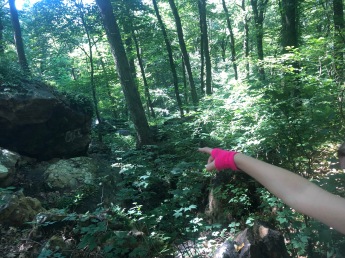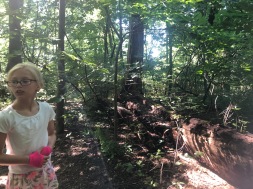
A person wants to get from point A to point B. Point B is on the other side of a forest. The first time that the person finds his way to point B, it takes a while. He gets scraped up. Some frustration may be involved. There will definitely be corrections in direction. He might use tools like GPS or a compass. Probably, the person will mark his travel. On the way back to point A, he will have an easier time of it.
The next time that the person wants to travel from point A to point B, it will take far less time and work. Plus, the person will not get as beat up, because he will know where the briars and boulders lie, and he will avoid them. He might even cut them back or move them, if he plans to travel this way regularly.

Now that there is a trail to follow, getting from point A to point B is easy, fast, and thoughtless. You know what to expect. You look forward to the natural outcroppings of rocks and groupings of trees that mark your progress along the route.
Technology has developed to the point that mountain bikes are available and in vogue. You get one and begin using it on your favorite trail.Getting from point A to point B evolves into a recreational activity. While you use the trail to get from one place to the other, the journey has become the entertaining part of the trip. You even invest some time in building parts of the trail to make them more fun. A straight path up a hill becomes a switchback with berms. Maybe you search out gnarly terrain to shred instead of racing directly to the end of the trail.
Eventually, your passion and excitement is communicated to others, and they want to try your trail. It morphs from a singletrail to a wider path.

Next, people who don’t mountain bike find that your trail is a convenient path from point A to point B, and they begin using it. Now, there are bikers and hikers. The hikers don’t need the entertaining gnarl of the mountain biking trail. They level portions, clear your favorite bunnyhopping logs, and widen the path.
As more and more people use the path for traveling, the importance of getting from point A to point B in less and less time with fewer distractions becomes valuable. It gets leveled, and then paved. It grows wider and marked. Eventually, your entertaining path turns into a rode.
Why does the last word of the previous paragraph look rong? Wait. What is happening hear?! Why are these homophones being spelled incorrectly?
This entire blog is an analogy for learning to read. These supposed misspellings at the end are obstacles for you to mentally bunnyhop over. If you have made it to this point*, you are a masterful reader who uses sounds, spellings, and can identify common letter groupings unconsciously.
Hopefully, you didn’t “yardsale” when you red (I just did it again! Ha ha) the word “rode”. It is ironic that the past tense verb for mentally travelling through this text would sound the same as the noun for the symbol of the text itself! Daniel T. Willingham rights (Sorry, I can’t help myself! Last time, I promise) about how our mind translates text when we read in “The Reading Mind” (2017). With wildly entertaining (at least for a geek like me) examples and figures, he explains the way we interpret sounds, decode meanings, and relate commonly used letter groupings. Reading this book shows how technical this seemingly simple task is, as well as how natural it becomes once we figure it out. Chapter 3 “Reading At A Glance” was the inspiration for this blog.
And now to wrap it up. The point** I was trying to make was that the process of reading evolves in each of us, and we get better at it by doing it. As adults, we read many texts that get us from point A (ignorance) to point B (knowledgeable) with the goal of speedily fixing our ignorant situation. This is often necessary and important. It is the goal of teachers to train students to be able to read well, so that they can also easily traverse the distance between point A and B. Given that this skill is refined by much repetition, wouldn’t it behoove the practicing reader to enjoy the process?
I am composing this blog to challenge adults to model mountain biking through text, so that others see your example and want to try out the trail for themselves. I suggest you find something fun to read, and make it visible, modeling your performance to inspire others. If you are a teacher, show your students. If you are an administrator, spur on your teachers. If you are a parent, show your child how useful reading is.
There is an adult reading challenge that I threw together for Twitter users that you might enjoy using. I made this in order to inspire a game/social angle for sharing our mature reading habits publicly. Feel free to join me and other grownup readers as we share our mental mountain biking!

Source:
Willingham, D. T. (2017). The reading mind: A cognitive approach to understanding how the mind reads.
*Congratulations on successfully finding point B; the place where all of this is explained. **Point B, throughout the analogy was never a tangible place, but rather reading, itself.

Matt! You’ve been a beast on this blog in recent weeks, months. I really want to be part of this reading challenge and I’m going to work hard to follow this!! Love the mtb theme here, of course. Write on, bruh!! Write on.
LikeLiked by 1 person
Thanks, James! You know I thought of you for many reasons, writing this post; The hiking, biking, and writing.
It would be cool to see you use the Twitter reading challenge hashtag. You read a lot of things that I wouldn’t have known about. I’m not sure if I ever commented on it, but I remember reading one of your blogs that was a review of a book that was fascinating. It was a work of fiction about the Donner Party. The idea behind my challenge is too simply share our grown up experiences with reading. That’s it. Simple.
In the elementary school we place tons of emphasis on reading; learning to read, practicing, and growing. I had this hypothesis that kids would benefit from witnessing adults modeling reading.
It’d be neat to see what you are reading or have read. I wonder, now that I think about it, how different people’s reading styles vary. Do people sit down and read a lot a few times or a little often. Do you read like an addict, and then not at all for a while? It will be fun to share. I hope to see you there.
LikeLiked by 1 person